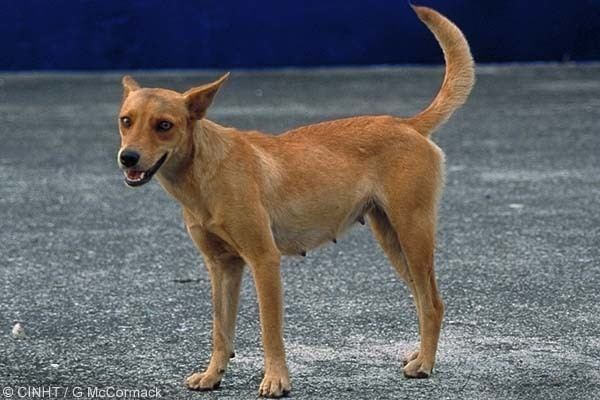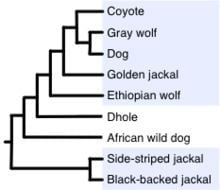Suborder Caniformia Tribe Canini | Scientific name Canis Rank Genus | |
 | ||
Height Gray wolf: 80 – 85 cm, Coyote: 58 – 66 cm, Black-backed jackal: 30 – 48 cm, Side-striped jackal: 35 – 50 cm Gestation period Gray wolf: 62 – 75 days, Coyote: 60 – 63 days, Black-backed jackal: 60 days, Side-striped jackal: 57 – 70 days Lower classifications Dog, Gray wolf, Coyote, Golden jackal, Red wolf | ||
Canis is a genus of canids containing multiple extant species, such as wolves, dogs and coyotes. Species of this genus are distinguished by their moderate to large size, their massive, well developed skulls and dentition, long legs, and comparatively short ears and tails.
Contents
- Etymology
- Terminology
- Canini
- Canis
- Evolution
- Wolves dogs and dingoes
- Coyotes jackals and wolves
- African migration
- References

Etymology

The generic name Canis means "dog" in Latin. The term "canine" comes from the adjective form, caninus ("of the dog"), from which the term canine tooth is also derived. The canine family has prominent canine teeth, used for killing their prey. The word canis is cognate to the Greek word kūon (Greek: Κύων), which means "dog", as well as (less transparently) English hound.
Terminology

Canini
The tribe Canini (Fischer de Waldheim, 1817) is the sister group to the foxes (vulpes), and is represented today by two sub-tribes: genus Canis that includes dogs, wolves, coyotes, jackals; and the genus Cerdocyonina that includes the so-called foxes of South America (Crab-eating fox). The critical features that mark the Canini as a monophyletic group include: the consistent enlargement of the frontal sinus, often accompanied by the correlated loss of the depression in the dorsal surface of the postorbital process; the posterior expansion of the paroccipital process; the enlargement of the mastoid process; and the lack of lateral flare of the orbital border of the zygoma.
Canis

The genus Canis (Carl Linnaeus, 1758) was published in the 10th edition of Systema Naturae and included the dog-like carnivores: the domestic dog, wolves, coyotes and jackals. All species within the Canis genus are phylogenetically closely related with 78 chromosomes and can potentially interbreed.
Evolution
The fossil record shows that Feliforms and Caniforms emerged within the super-family Carnivoramorpha 43 million YBP. The caniforms included the fox-like Leptocyon genus whose various species existed from 34 million YBP before branching 11.9 million YBP into vulpes (foxes) and canini (canines). The jackal-sized Eucyon existed in North America from 10 million YBP and by the Early Pliocene about 6-5 million YBP the coyote-like Eucyon davisi invaded Eurasia. In North America it gave rise to early Canis which first appeared in the Miocene (6 million YBP) in south-western USA and Mexico. By 5 million YBP the larger Canis lepophagus appeared in the same region.
The canids that had emigrated from North America to Eurasia – Eucyon, Vulpes, and Nyctereutes – were small to medium-sized predators during the Late Miocene and Early Pliocene but they were not the top predators. The position of the canids would change with the arrival of Canis to become a dominant predator across the Holarctic. The wolf-sized C. chihilensis appeared in northern China in the Mid-Pliocene around 4-3 million YBP. This was followed by an explosion of Canis evolution across Eurasia in the Early Pleistocene around 1.8 million YBP in what is commonly referred to as the Wolf event. It is associated with the formation of the Mammoth steppe and continental glaciation. Canis spread to Europe in the forms of C. arnensis, C. eutruscus, and C. falconeri. One study found that the diversity of the Canis group decreased by the end of the Early Pleistocene to Middle Pleistocene and was limited in Eurasia to the small wolves of the Canis mosbachensis–Canis variabilis group and the large hypercarnivorous Canis (Xenocyon) lycaonoides.
See further: Evolution of the canidsWolves, dogs and dingoes
Wolves, dogs, and dingoes are subspecies of Canis lupus. The original referent of the English word wolf, the Eurasian wolf, is called C. l. lupus to distinguish it from other wolf subspecies, such as the Indian wolf (C. l. pallipes), the Arabian wolf (C. l. arabs), or the Tibetan wolf (C. l. chanco).
Some experts have suggested some subspecies of C. lupus be considered Canis species distinct from C. lupus. These include Central Asia's Himalayan wolf, and the Indian wolf, as well as the North America's red wolf and eastern wolf.
The dingo (C. l. dingo), from Australasia, and the domestic dog (C. l. familiaris) are also considered subspecies of C. lupus, although they are not commonly referred to or thought of as "wolves".
Coyotes, jackals, and wolves
The Gray wolf (C. lupus), the Ethiopian wolf (C. simensis), and the African golden wolf (C. anthus) are three of the many Canis species referred to as "wolves"; however, all of the others are now extinct and little is known about them by the general public. One of these, the extinct dire wolf (C. dirus), has gained fame from the thousands of specimens found and displayed at the Rancho La Brea Tar Pits in Los Angeles, California.
Canis species that are too small to attract the word "wolf" are called coyotes in the Americas and jackals elsewhere. Although these may not be more closely related to each other than they are to C. lupus, they are, as fellow Canis species, all more closely related to wolves and domestic dogs than they are to foxes, maned wolves, or other canids which do not belong to the genus Canis. The word "jackal" is applied to three distinct species of this group: the side-striped (C. adustus) and black-backed (C. mesomelas) jackals, found in sub-Saharan Africa, and the golden jackal (C. aureus), found across southwestern and south-central Asia, and the Balkans.
While North America has only one small-sized species, the coyote (C. latrans), it has become very widespread, moving into areas once occupied by wolves. They can be found across much of mainland Canada, in every state of the contiguous United States, all of Mexico except the Yucatán Peninsula, and the Pacific and central areas of Central America, ranging as far as western Panama.
African migration
In 2015, a study of mitochondrial genome sequences and whole genome nuclear sequences of African and Eurasian canids indicated that extant wolf-like canids have colonised Africa from Eurasia at least 5 times throughout the Pliocene and Pleistocene, which is consistent with fossil evidence suggesting that much of African canid fauna diversity resulted from the immigration of Eurasian ancestors, likely coincident with Plio-Pleistocene climatic oscillations between arid and humid conditions. When comparing the African and Eurasian golden jackals, the study concluded that the African specimens represented a distinct monophyletic lineage that should be recognized as a separate species, Canis anthus (African golden wolf). According to a phylogeny derived from nuclear sequences, the Eurasian golden jackal (Canis aureus) diverged from the wolf/coyote lineage 1.9 million years ago but the African golden wolf separated 1.3 million years ago. Mitochondrial genome sequences indicated the Ethiopian wolf diverged from the wolf/coyote lineage slightly prior to that.
